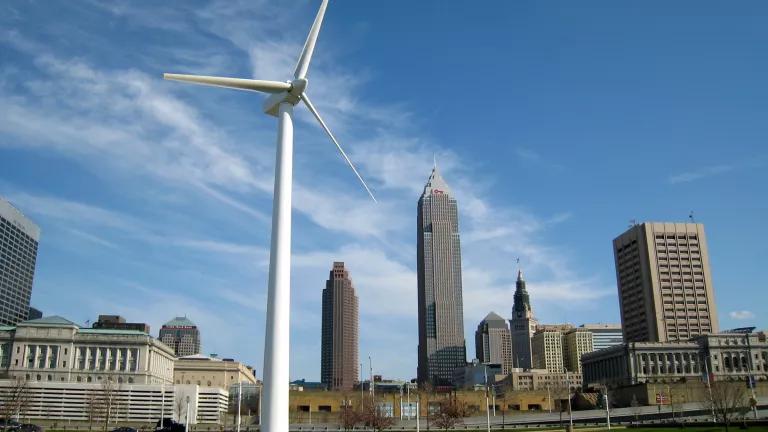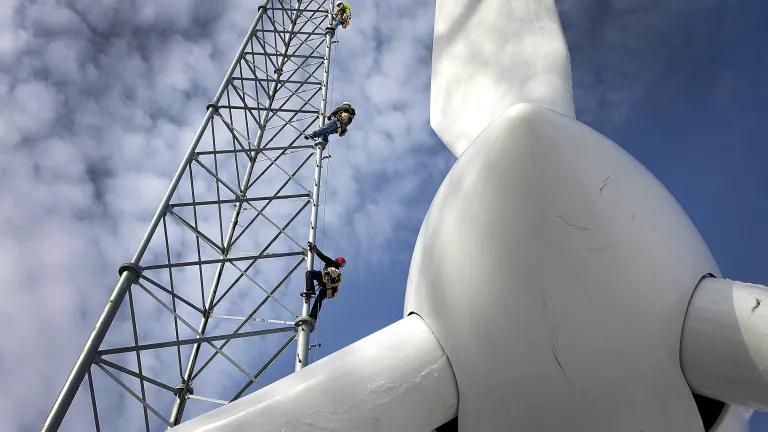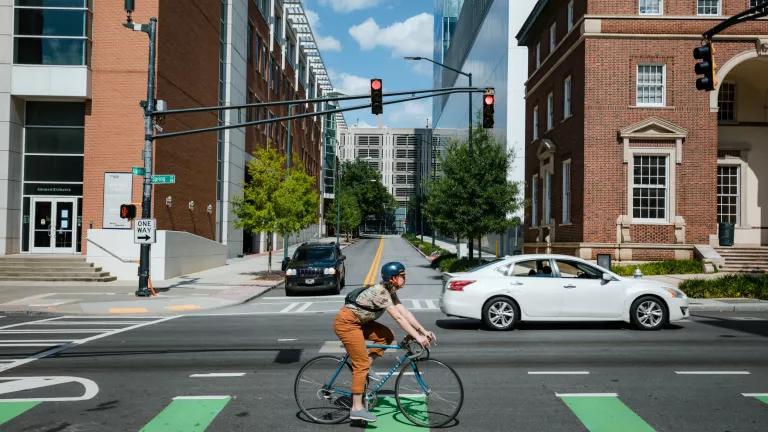Green New Deal Rises to Scale of Climate Challenge

After dire climate reports and devastating wildfires, hurricanes, and floods affecting Americans across the country, it's a breath of fresh air to see leaders working toward climate solutions to protect us today and ensure our kids don’t inherit a climate catastrophe tomorrow.
Today, a new member of the House of Representatives and a seasoned veteran of the Senate joined forces to push forward the concept of a “Green New Deal.” Representative Alexandria Ocasio-Cortez (better known as AOC) and Senator Edward Markey introduced joint House and Senate resolutions that outline the scope, ambition, and goals under the Green New Deal umbrella. The momentum for a Green New Deal has been growing steadily since last November, after Democrats won the House majority in the 2018 midterms. Public pressure is intensifying on members of Congress to show climate leadership, and Representative Ocasio-Cortez and Senator Markey are rising to the occasion.
It is a breath of fresh air to see leaders discussing climate solutions that rise to the scale of the challenge. After fighting in the climate trenches for nearly 20 years, I feel especially optimistic and reenergized by these new calls to action. America must move as quickly as possible to a 100 percent clean energy economy, with policies and programs that end climate pollution, create millions of high-quality American jobs, reduce inequality and poverty, and safeguard communities from climate and environmental hazards. Thousands of people are still reeling from last year’s devastating wildfires, hurricanes, and floods, and more and more Americans realize that their families are at risk from climate damage. We need to protect ourselves today and ensure our kids don’t inherit a climate catastrophe tomorrow. The solution requires an inspiring and daunting economic metamorphosis of historic proportions.
Enter the resolution from Representative Ocasio-Cortez and Senator Markey. Their Green New Deal framework is wide-ranging in scope and ambition, with several goals that could spur dozens of separate policy solutions. Three key themes in the Green New Deal (GND) resolution stand out in particular: achieve net-zero greenhouse gas emissions; establish a safe and healthy environment for all; and promote equity and justice for workers, frontline communities, and vulnerable populations.
Achieve net-zero greenhouse gas emissions
NRDC enthusiastically supports the declaration in this resolution that the federal government has the duty to chart a path for our country to achieve net-zero greenhouse gas emissions. In my opinion, this should be in ALL CAPS, bolded, and highlighted in yellow. While the GND resolution does not assert a timeline to achieve net-zero (or carbon neutrality), the blockbuster IPCC report released last October confirms that, globally, we must reach the net-zero benchmark by midcentury to keep warming below 1.5 degrees Celsius and avoid the worst consequences of climate change. “Net-zero” means producing almost all our energy from carbon-pollution-free sources and removing carbon from the atmosphere to balance out the remaining pollution sources that take longer to completely decarbonize. NRDC supports the ambitious and achievable goal to reach net-zero greenhouse gases by 2050. The United States can achieve this goal by cutting energy waste, scaling up clean energy solutions, and expanding natural and technological carbon removal approaches.
The resolution includes essential investment needs through “10-year mobilizations” for key projects that will move America toward net-zero, such as:
- Transitioning the electricity sector to clean, zero-emission energy sources and enhancing power grid efficiency
- Upgrading buildings to be more energy and water efficient, and to transition building energy uses to electric sources
- Investing in clean technologies for industry and manufacturing
- Expanding the use of zero-emission vehicles and public transit
- Restoring natural ecosystems and enhancing agricultural practices that remove carbon pollution from the atmosphere
Addressing climate pollution from each of these sectors is crucial to reach the net-zero emissions target. We need an all-hands-on-deck approach, and the resolution’s blueprint to reduce pollution can serve as a basis to build specific policies in coming months and years. The resolution also mentions the requirement for more federal investment for research and development of clean technologies, as well as the need to account for the complete environmental and social cost of emissions. This latter point is no doubt a reference to the hidden costs of pollution shouldered by the public since the start of the industrial revolution. The most important way to account for this true cost and achieve net-zero emissions is through federal policies that specifically limit climate pollution. There are countless ways for Congress to design such policies; my colleagues David Doniger and Derek Murrow addressed several ideas for R&D, deployment policies, and pollution standards in a recent blog.
Establish a safe, sustainable and healthy environment for all
The resolution raises several other meaningful environmental objectives that extend beyond greenhouse gas reductions. Achieving net-zero climate pollution is an ambitious goal by itself, but Senator Markey and Representative Ocasio-Cortez also recognize that net zero is not enough to ensure a safe, healthy environment for all Americans. NRDC applauds the goals for investments in sustainable infrastructure and industry, and the goals to secure clean air, clean water, climate resilience, healthy food, and access to nature for all. Several significant projects in the resolution address this broader set of environmental goals, including:
- Building resilience to climate-related disasters and alleviating long-term effects of all types of pollution, especially through funding for community-defined strategies
- Upgrading infrastructure to reduce pollution, to ensure access to clean water, and to reduce risks from climate impacts
- Cleaning up hazardous waste and abandoned sites to promote economic development and sustainability
- Restoring and protecting fragile ecosystems to protect biodiversity and support climate resiliency
- Building a more sustainable food system that ensures access to healthy food
Promote equity and justice for workers, frontline communities, and vulnerable populations
As in the original New Deal, job creation and supporting workers is a core tenet of the Green New Deal. The authors of the resolution, citing the historical exclusion of frontline and vulnerable communities from the benefits of the original New Deal, have built the GND resolution on a foundational principle to lift up communities that are overburdened and historically oppressed. With labor organizations, environmental justice groups, and community leaders, NRDC works in partnership to pursue equity and just transition within climate solutions. NRDC strongly supports the equity and justice principles in the Green New Deal resolution.
The resolution takes an important step forward in the pursuit of equity by calling for an inclusive process that empowers workers and community leaders to develop Green New Deal projects. It aims to create millions of high-wage jobs, ensure economic security for all, and prioritize economic and environmental benefits in frontline and vulnerable communities. Some of the key projects to promote equity and justice include:
- Providing training and high-quality education for all, and ensuring participatory processes that are inclusive of and led by frontline and vulnerable communities and workers to plan, implement, and administer Green New Deal projects at the local level
- Strengthening and enforcing labor, workplace health and safety, and wage standards across all employers, industries and sectors
- Recognizing the right of all workers to organize, unionize, and collectively bargain
Americans are united around the need for real climate action and a more just economy—and the momentum is growing for Congress to deliver solutions. Representative Ocasio-Cortez and Senator Markey are showing true leadership with inspiring and essential goals to tackle climate change. Their Green New Deal framework provides a roadmap to achieve a 100 percent clean energy economy and net-zero pollution, with social justice at the core of the solutions. It’s long past time for us to come together as a country around the urgent need for climate action. Climate change is not a partisan issue that divides us—it is a crisis that unites all of us, as a nation, in the need to act.



